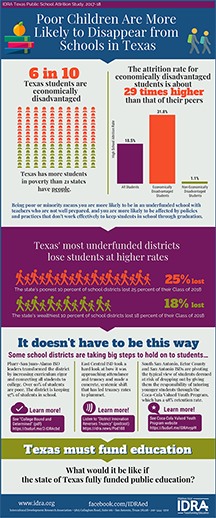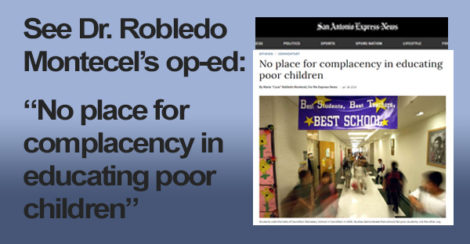The Attrition Rates for Poor Students is 29 Times Higher than for other Texas Students
 San Antonio (January 31, 2019) – Texas schools, particularly those in low wealth districts and large urban areas, are more likely to lose students who are poor than students who are not. This is an especially troubling trend in a state where three out of five children are economically disadvantaged. In an additional analysis to IDRA’s annual attrition study released in December 2018, IDRA examined data from a national and statewide perspective on attrition rates of economically disadvantaged students and examined the issue in terms of school district property wealth.
San Antonio (January 31, 2019) – Texas schools, particularly those in low wealth districts and large urban areas, are more likely to lose students who are poor than students who are not. This is an especially troubling trend in a state where three out of five children are economically disadvantaged. In an additional analysis to IDRA’s annual attrition study released in December 2018, IDRA examined data from a national and statewide perspective on attrition rates of economically disadvantaged students and examined the issue in terms of school district property wealth.
Key findings show:
- For the class of 2017, the attrition rate reported by the Texas Education Agency for economically disadvantaged students was about 29 times higher than that of their peers. The attrition rate for economically disadvantaged students was 31.8 percent while the rate for non-economically disadvantaged students was 1.1 percent.
- About six out of 10 students in Texas public schools are identified as economically disadvantaged. Texas has more students in poverty than 21 states have people of all ages and incomes.
- Attrition rates are higher in property poor districts and large urban areas. The state’s poorest 10 percent of school districts in terms of property wealth had an attrition rate of 25.1 percent compared do a 17.7 percent attrition rate in the highest wealth group.
- Texas ranked second nationally in on-time graduation rates of economically disadvantaged students with a rate of 86.0 percent compared to the national average of 77.6 percent in 2015-16. But Texas ranked 10th in graduating another large subgroup of students: English learners with a rate of 73.7 percent.
- The school district groups with high attrition rates include large urban school districts (e.g., Austin, Dallas, Houston), suggesting that average property wealth districts could benefit from increased funding that would be generated by increasing compensatory and English learner funding weights.
Research indicates that compensatory education costs in Texas average about 40 percent of a school district’s regular program costs (as do English learner education costs). Despite research at the time pointing to the need for higher percentages, policymakers in 1984 adopted a 10 percent add-on weight for bilingual and ESL programs and a 20 percent add-on weight for state compensatory education programs serving low-income students. And no change in those original weights has been made.
IDRA research also shows that most, if not all, school districts would benefit significantly from an increase in these funding weights.
“Being poor or minority means you are more likely to be in an underfunded school with teachers who are not well prepared, and you are more likely to be affected by policies and practices that don’t work effectively to keep students in school through graduation,” concluded Researchers Roy Johnson, M.S., and Charles Cavazos. “Underfunding of public schools overall and lack of adequate support for educating special populations is harming poor students, who are our largest group of students.”
 “The fact that some school districts are taking steps to improve their school holding power, and their investment in dropout prevention programs and college readiness initiatives is paying off counters the claims by many state and school leaders that certain schools are having a more difficult time because of the student population they serve,” added IDRA President & CEO, Dr. María “Cuca” Robledo Montecel. “The underlying message of ‘We would do better if we had better kids’ is that some kids – minority, poor, English learners – are, by their very being, difficult to teach. But children are not the problem… The characteristics of the children are absolutely not what leads schools to fail to graduate all students.”
“The fact that some school districts are taking steps to improve their school holding power, and their investment in dropout prevention programs and college readiness initiatives is paying off counters the claims by many state and school leaders that certain schools are having a more difficult time because of the student population they serve,” added IDRA President & CEO, Dr. María “Cuca” Robledo Montecel. “The underlying message of ‘We would do better if we had better kids’ is that some kids – minority, poor, English learners – are, by their very being, difficult to teach. But children are not the problem… The characteristics of the children are absolutely not what leads schools to fail to graduate all students.”
IDRA released a report, College Bound and Determined, in February 2014 showing how one south Texas school district serving a high proportion of economically disadvantaged students transformed itself. The result was a school district that doubled its number of high school graduates, cut dropout rates in half and increased college-going rates.
“The state of Texas is required to provide an excellent education for all students. Our state must shore up neighborhood public schools where all students graduate from high school prepared for college or the world of work, no matter what the color of their skin, the language they speak, or where they happen to be born,” Dr. Robledo Montecel continued.
IDRA’s Quality School Action Framework™ guides communities and schools in identifying weak areas and strengthening public schools’ capacities to graduate and prepare all students for success.
IDRA’s attrition study and supplemental reports are available online.
# # #
Media Contact: Christie L. Goodman, APR, at IDRA, 210-444-1710; christie.goodman@idra.org
See Reporter FAQs, Images and Resources Regarding Attrition and Dropout Data


